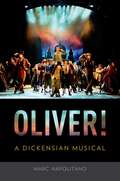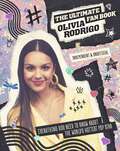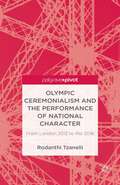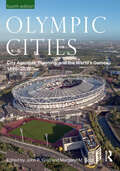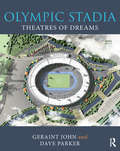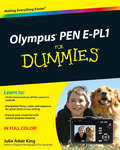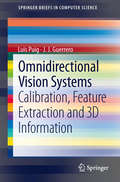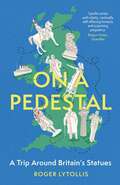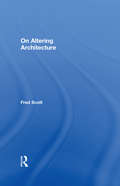- Table View
- List View
Olfactory Art and the Political in an Age of Resistance (Routledge Advances in Art and Visual Studies)
by Gwenn-Aël Lynn Debra Riley ParrThis book claims a political value for olfactory artworks by situating them squarely in the contemporary moment of various forms of political resistance. Each chapter presents the current research and art practices of an international group of artists and writers from the United States, Canada, France, Germany, Switzerland, Thailand, Sweden, and the Netherlands. The book brings together new thinking on the potential for olfactory art to critique and produce modes of engagement that challenge the still-powerful hegemonic realities of the twenty-first century, particularly the dominance of vision as opposed to other sensory modalities. The book will be of interest to scholars working in contemporary art, art history, visual culture, olfactory studies, performance studies, and politics of activism.
Olga's Room: Olga's Room - Innocence - Land Without Words (Oberon Modern Plays)
by Dea Loher David TushinghamThe only way not to be a heroine, a martyr, a victim, is to make myself an accomplice, a collaborator. Communist. Jew. Revolutionary. Lover. Mother. Olga Benario's story is a searing tale of survival as alongside her fellow prisoners she struggles to hold onto her disintegrating sense of self. Based on real events of the 1930s-40s focusing on Benario's time in Brazil and Germany, this gripping play was the first work by one of Europe's foremost contemporary dramatists, Dea Loher, and was originally performed in 1992. After their highly successful run in Luxembourg City, Speaking in Tongues bring the English-language world premiere to London.
Oliver!: A Dickensian Musical
by Marc NapolitanoWhen the show was first produced in 1960, at a time when transatlantic musical theatre was dominated by American productions, Oliver! already stood out for its overt Englishness. But in writing Oliver!, librettist and composer Lionel Bart had to reconcile the Englishness of his Dickensian source with the American qualities of the integrated book musical. To do so, he turned to the musical traditions that had defined his upbringing: English music hall, Cockney street singing, and East End Yiddish theatre. This book reconstructs the complicated biography of Bart's play, from its early inception as a pop musical inspired by a marketable image, through its evolution into a sincere Dickensian adaptation that would push English musical theatre to new dramatic heights. The book also addresses Oliver!'s phenomenal reception in its homeland, where audiences responded to the musical's Englishness with a nationalistic fervor. The musical, which has more than fulfilled its promise as one of the most popular English musicals of all time, remains one of the country's most significant shows. Author Marc Napolitano shows how Oliver!'s popularity has ultimately exerted a significant influence on two separate cultural trends. Firstly, Bart's adaptation forever impacted the culture text of Dickens's Oliver Twist; to this day, the general perception of the story and the innumerable allusions to the novel in popular media are colored heavily by the sights, scenes, sounds, and songs from the musical, and virtually every major adaptation of from the 1970s on has responded to Bart's work in some way. Secondly, Oliver! helped to move the English musical forward by establishing a post-war English musical tradition that would eventually pave the way for the global dominance of the West End musical in the 1980s. As such, Napolitano's book promises to be an important book for students and scholars in musical theatre studies as well as to general readers interested in the megamusical.
Oliver!: A Dickensian Musical
by Marc NapolitanoWhen the show was first produced in 1960, at a time when transatlantic musical theatre was dominated by American productions, Oliver! already stood out for its overt Englishness. But in writing Oliver!, librettist and composer Lionel Bart had to reconcile the Englishness of his Dickensian source with the American qualities of the integrated book musical. To do so, he turned to the musical traditions that had defined his upbringing: English music hall, Cockney street singing, and East End Yiddish theatre. This book reconstructs the complicated biography of Bart's play, from its early inception as a pop musical inspired by a marketable image, through its evolution into a sincere Dickensian adaptation that would push English musical theatre to new dramatic heights. The book also addresses Oliver!'s phenomenal reception in its homeland, where audiences responded to the musical's Englishness with a nationalistic fervor. The musical, which has more than fulfilled its promise as one of the most popular English musicals of all time, remains one of the country's most significant shows. Author Marc Napolitano shows how Oliver!'s popularity has ultimately exerted a significant influence on two separate cultural trends. Firstly, Bart's adaptation forever impacted the culture text of Dickens's Oliver Twist; to this day, the general perception of the story and the innumerable allusions to the novel in popular media are colored heavily by the sights, scenes, sounds, and songs from the musical, and virtually every major adaptation of from the 1970s on has responded to Bart's work in some way. Secondly, Oliver! helped to move the English musical forward by establishing a post-war English musical tradition that would eventually pave the way for the global dominance of the West End musical in the 1980s. As such, Napolitano's book promises to be an important book for students and scholars in musical theatre studies as well as to general readers interested in the megamusical.
Oliver Lansley: Les Enfants Terribles Collected Plays (Oberon Modern Playwrights)
by Oliver LansleyLes Enfants Terribles is a collection of three plays from one of Britain's most innovative theatre companies. It is also a document of the company's progress so far, featuring detailed production photos, design sketches and introductions to each play. The Terrible Infants (2007) blends puppetry, live music, performance and story-telling to present a series of twisted tales for children and adults. Inspired by the likes of Edgar Allen Poe and Alfred Hitchcock, Ernest and the Pale Moon (2008) is a noir horror based upon a tale of murderous envy. The Vaudevillains (2011) is a dark miniature musical whodunnit. When the owner of a music hall is murdered, everyone's a suspect. Released to coincide with the Edinburgh Festival 2011, where Les Enfant Terribles will be performing at Edinburgh Festival, Pleasance Courtyard, August 6-29th
Olivia Rodrigo - Ultimate Fan Book (The Ultimate Fan Book)
by Malcolm CroftDiscover everything you need to know about the world's hottest young pop star in Olivia Rodrigo - The Ultimate Fan Book.Since releasing her debut single 'Drivers Licence' in January 2021, Olivia Rodrigo has rocketed to the top of charts around the world, and quickly become not only one of the most exciting young singer-songwriters of the moment, but one of the biggest stars in the world today. In Olivia Rodrigo - The Ultimate Fan Book, you'll discover how this former Disney starlet has found such amazing success with her catchy songs, striking fashion choices and incredible charm.Through lively text and dozens of gorgeous photographs, this Fan Book follows the rise and rise of Olivia, from High School Musical to her acclaimed album Sour, and highlights how she's only just getting started. Filled with quotes from Olivia and her closest collaborators, discussing fame, fashion, fans and more, as well as tons of stunning snaps from the red carpet to stadium stages, Olivia Rodrigo - The Ultimate Fan Book takes you onstage, in the studio and behind the scenes with one of the brightest stars on the planet.
Olympia (BFI Film Classics)
by Taylor DowningLeni Riefenstahl's Olympia (1938) is one of the most controversial films ever made. Capitalising on the success of Triumph of the Will (1935), her propaganda film for the Nazi Party, Riefenstahl secured Hitler's approval for her grandiose plans to film the 1936 Berlin Olympics. The result was a work as notorious for its politics as celebrated for its aesthetic power. This revised edition includes new material on Riefenstahl's film-making career before Olympia and her close relationship with Hitler. Taylor Downing also discusses newly-available evidence on the background to the film's production that conclusively proves that the film was directly commissioned by Hitler and funded through Goebbels's Ministry of Propaganda and not, as Riefenstahl later claimed, commissioned independently from the Nazi state by the Olympic authorities. In writing this edition, Taylor Downing has been given access to a magnificent new restoration of the original version of the film by the International Olympic Committee.
Olympia (BFI Film Classics)
by Taylor DowningLeni Riefenstahl's Olympia (1938) is one of the most controversial films ever made. Capitalising on the success of Triumph of the Will (1935), her propaganda film for the Nazi Party, Riefenstahl secured Hitler's approval for her grandiose plans to film the 1936 Berlin Olympics. The result was a work as notorious for its politics as celebrated for its aesthetic power. This revised edition includes new material on Riefenstahl's film-making career before Olympia and her close relationship with Hitler. Taylor Downing also discusses newly-available evidence on the background to the film's production that conclusively proves that the film was directly commissioned by Hitler and funded through Goebbels's Ministry of Propaganda and not, as Riefenstahl later claimed, commissioned independently from the Nazi state by the Olympic authorities. In writing this edition, Taylor Downing has been given access to a magnificent new restoration of the original version of the film by the International Olympic Committee.
Olympic Ceremonialism and The Performance of National Character: From London 2012 to Rio 2016 (Palgrave Studies in the Olympic and Paralympic Games)
by R. TzanelliThis book examines the London 2012 opening and closing ceremonies and the handover to Rio 2016 as articulations of national and cosmopolitan belonging. The ceremonial performances supported imaginative travel and created a tornadóros: an ideal form of 'human' that manipulates audiovisual narratives of culture and identity for global audiences.
Olympic Cities: City Agendas, Planning, and the World’s Games, 1896 – 2032 (ISSN)
by John R. Gold Margaret M. GoldThe first edition of Olympic Cities, published in 2007, provided a pioneering overview of the changing relationship between cities and the modern Olympic Games. This substantially revised and much enlarged fourth edition builds on the success of its predecessors. The first of its three parts provides overviews of the urban legacy of the four component Olympic festivals: the Summer Games; Winter Games; Cultural Olympiads; and the Paralympics. The second part comprises systematic surveys of six key aspects of activity involved in staging the Olympics and Paralympics: finance; sustainability; the creation of Olympic Villages; security; urban regeneration; and tourism. The final part consists of ten chronologically arranged portraits of host cities from 1960 to 2032, with complete coverage of the Summer Games of the twenty-first century.As controversy over the growing size and expense of the Olympics, with associated issues of democratic accountability and legacy, continues unabated, this book’s incisive and timely assessment of the Games’ development and the complex agendas that host cities attach to the event will be essential reading for a wide audience. This will include not just urban and sports historians, urban geographers, event managers, and city planners, but also anyone with an interest in the staging of mega-events and concerned with building a better understanding of the relationship between cities, sport, and culture.
Olympic Cities: City Agendas, Planning, and the World’s Games, 1896 – 2032 (ISSN)
The first edition of Olympic Cities, published in 2007, provided a pioneering overview of the changing relationship between cities and the modern Olympic Games. This substantially revised and much enlarged fourth edition builds on the success of its predecessors. The first of its three parts provides overviews of the urban legacy of the four component Olympic festivals: the Summer Games; Winter Games; Cultural Olympiads; and the Paralympics. The second part comprises systematic surveys of six key aspects of activity involved in staging the Olympics and Paralympics: finance; sustainability; the creation of Olympic Villages; security; urban regeneration; and tourism. The final part consists of ten chronologically arranged portraits of host cities from 1960 to 2032, with complete coverage of the Summer Games of the twenty-first century.As controversy over the growing size and expense of the Olympics, with associated issues of democratic accountability and legacy, continues unabated, this book’s incisive and timely assessment of the Games’ development and the complex agendas that host cities attach to the event will be essential reading for a wide audience. This will include not just urban and sports historians, urban geographers, event managers, and city planners, but also anyone with an interest in the staging of mega-events and concerned with building a better understanding of the relationship between cities, sport, and culture.
Olympic Stadia: Theatres of Dreams
by Geraint John Dave ParkerOlympic Stadia provides a comprehensive account of the development of stadia including but not limited to: developments in running tracks, the introduction of lighting, improvements in spectator viewing standards and the introduction of roofs. Written by a world-renowned expert on sports architecture, the book: Systematically analyses every stadium from Athens 1896 to Tokyo 2020 Provides drawings, plans, elevations, photographs and illustrations in full colour Considers the fundamental changes wrought by the incorporation of the Paralympic Games Looks at the impact on host cities and their urban infrastructure, and considers the long-term legacies and massive investments that Olympic stadia require Explores the effects of the demands of the world’s TV broadcasters. An invaluable and beautiful resource for practical insight and inspiration, this book makes essential reading for anyone interested in Olympic stadia.
Olympic Stadia: Theatres of Dreams
by Geraint John Dave ParkerOlympic Stadia provides a comprehensive account of the development of stadia including but not limited to: developments in running tracks, the introduction of lighting, improvements in spectator viewing standards and the introduction of roofs. Written by a world-renowned expert on sports architecture, the book: Systematically analyses every stadium from Athens 1896 to Tokyo 2020 Provides drawings, plans, elevations, photographs and illustrations in full colour Considers the fundamental changes wrought by the incorporation of the Paralympic Games Looks at the impact on host cities and their urban infrastructure, and considers the long-term legacies and massive investments that Olympic stadia require Explores the effects of the demands of the world’s TV broadcasters. An invaluable and beautiful resource for practical insight and inspiration, this book makes essential reading for anyone interested in Olympic stadia.
Olympus PEN E-PL1 For Dummies
by Julie Adair KingA friendly guide to the Olympus E-PL1, the latest trend in digital cameras Hybrids offer the flexibility of interchangeable lenses and a large sensor in a smaller body. The Olympus E-PL1 lightens your load without sacrificing shooting power and this fun and friendly guide helps you better understand your camera's controls, features, and potential. Veteran author Julie Adair King presents you with examples on how to use your camera's main functions in order to create effective and memorable digital photos. Explains how to work with lenses and shoot in auto mode Covers the on-board controls and situational shooting Addresses manipulating focus and color controls Discusses printing, posting online, and other ways to share images Get started shooting with Olympus E-PL1 For Dummies!
Olympus PEN E-PL1 For Dummies
by Julie Adair KingA friendly guide to the Olympus E-PL1, the latest trend in digital cameras Hybrids offer the flexibility of interchangeable lenses and a large sensor in a smaller body. The Olympus E-PL1 lightens your load without sacrificing shooting power and this fun and friendly guide helps you better understand your camera's controls, features, and potential. Veteran author Julie Adair King presents you with examples on how to use your camera's main functions in order to create effective and memorable digital photos. Explains how to work with lenses and shoot in auto mode Covers the on-board controls and situational shooting Addresses manipulating focus and color controls Discusses printing, posting online, and other ways to share images Get started shooting with Olympus E-PL1 For Dummies!
The Omen (Devil's Advocates)
by Adrian SchoberDirected by Richard Donner and written by David Seltzer, The Omen (1976) is perhaps the best in the devil-child cycle of movies that followed in the wake of Rosemary’s Baby and The Exorcist. Released to a highly suggestible public, The Omen became a major commercial success, in no small part due to an elaborate pre-sell campaign that played and preyed on apocalyptic fears and a renewed belief in the Devil and the supernatural. Since polarising critics and religious groups upon its release, The Omen has earned its place in the horror film canon. It’s a film that works on different levels, is imbued with nuance, ambiguity and subtext, and is open to opposing interpretations. Reflecting the film’s cultural impact and legacy, the name ‘Damien’ has since become a pop culture byword for an evil child. Adrian Schober’s Devil’s Advocate entry covers the genesis, authorship, production history, marketing and reception of The Omen, before going on to examine the overarching theme of paranoia that drives the narrative: paranoia about the 'end times'; paranoia about government and conspiracy; paranoia about child rearing (especially, if one strips away the layer of Satanism); and paranoia about imagined threats to the right-wing Establishment from liberal and post-countercultural forces of the 1970s.
Omnibus Films: Theorizing Transauthorial Cinema
by David Scott DiffrientOmnibus films bring together the contributions of two or more filmmakers. Does this make them inherently contradictory texts? How do they challenge critical categories in cinema studies? What are their implications for auteur theory? As the first book-length exploration of internationally distributed, multi-director episode films, David Scott Diffrient’s Omnibus Films: Theorizing Transauthorial Cinema fills a considerable gap in the history of world cinema and aims to expand contemporary understandings of authorship, genre, narrative, and transnational production and reception. Delving into such unique yet representative case studies as If I Had a Million (1932), Forever and a Day (1943), Dead of Night (1945), Quartet (1948), Love and the City (1953), Boccaccio ’70, (1962), New York Stories (1989), Tickets (2005), Visions of Europe (2005), and Paris, je t’aime (2006), this book covers much conceptual ground and crosses narrative as well as national borders in much the same way that omnibus films do. Omnibus Films is a particularly thought-provoking book for those working in the fields of auteur theory, film genre and transnational cinema, and is suitable for advanced students in Cinema Studies.
Omnibus Films: Theorizing Transauthorial Cinema (Edinburgh University Press)
by David Scott DiffrientOmnibus films bring together the contributions of two or more filmmakers. Does this make them inherently contradictory texts? How do they challenge critical categories in cinema studies? What are their implications for auteur theory? As the first book-length exploration of internationally distributed, multi-director episode films, David Scott Diffrient’s Omnibus Films: Theorizing Transauthorial Cinema fills a considerable gap in the history of world cinema and aims to expand contemporary understandings of authorship, genre, narrative, and transnational production and reception. Delving into such unique yet representative case studies as If I Had a Million (1932), Forever and a Day (1943), Dead of Night (1945), Quartet (1948), Love and the City (1953), Boccaccio ’70, (1962), New York Stories (1989), Tickets (2005), Visions of Europe (2005), and Paris, je t’aime (2006), this book covers much conceptual ground and crosses narrative as well as national borders in much the same way that omnibus films do. Omnibus Films is a particularly thought-provoking book for those working in the fields of auteur theory, film genre and transnational cinema, and is suitable for advanced students in Cinema Studies.
Omnidirectional Vision Systems: Calibration, Feature Extraction and 3D Information (SpringerBriefs in Computer Science)
by Luis Puig J J GuerreroThis work focuses on central catadioptric systems, from the early step of calibration to high-level tasks such as 3D information retrieval. The book opens with a thorough introduction to the sphere camera model, along with an analysis of the relation between this model and actual central catadioptric systems. Then, a new approach to calibrate any single-viewpoint catadioptric camera is described. This is followed by an analysis of existing methods for calibrating central omnivision systems, and a detailed examination of hybrid two-view relations that combine images acquired with uncalibrated central catadioptric systems and conventional cameras. In the remaining chapters, the book discusses a new method to compute the scale space of any omnidirectional image acquired with a central catadioptric system, and a technique for computing the orientation of a hand-held omnidirectional catadioptric camera.
On a Pedestal: A Trip around Britain's Statues
by Roger LytollisThis is a book for people who are interested in statues . . . and for people who aren't. It explores those immortalised in marble and bronze - and what the rest of us think about them.As Roger Lytollis travels Britain he encounters a man at Liverpool's Beatles statue convinced that Rod Stewart was in the Fab Four. In Edinburgh he walks into a row over Greyfriars Bobby's nose and in Glasgow learns why the Duke of Wellington wears a traffic cone on his head. London brings a controversial nude statue and some hard truths about racism.Elsewhere, Roger sees people dancing with Eric Morecambe, finds a statue being the backdrop to a marriage proposal and, everywhere he goes, pigeons. Always pigeons . . .On a Pedestal is the first book to examine public statues around the nation. It looks at their emergence into our culture wars; the trend for portraying musicians, sports stars and comedians rather than monarchs, politicians and generals; the amazing tales of many of those commemorated on our streets.It also features interviews with sculptors, including Sir Antony Gormley, telling the stories behind some of our most popular modern statues.Part history book, part travelogue, On a Pedestal brings statues to life. Informative and entertaining, it's a book that - ultimately - is more about blood than bronze.
On Altering Architecture
by Fred ScottBringing together interior design and architectural theory, this exciting text looks at the common practices of building alteration, reconsidering established ideas and methods, to initiate the creation of a theory of the interior or interventional design. Fred Scott examines in-depth case studies of interventional design from architectural history across the world – examples discussed are taken from the States, Europe and Japan. Scott expands and builds on the ideas of Viollet-le-Duc, structuralism and other thoughts to layout criteria for an art of intervention and change. The book draws on the philosophy of conservation, preservation and restoration, as well as exploring related social and political issues. For those in professions of architecture and interiors, town planners, and students in architecture and art schools, On Altering Architecture forms a body of thought that can be aligned and compared with architectural theory.
On Altering Architecture
by Fred ScottBringing together interior design and architectural theory, this exciting text looks at the common practices of building alteration, reconsidering established ideas and methods, to initiate the creation of a theory of the interior or interventional design. Fred Scott examines in-depth case studies of interventional design from architectural history across the world – examples discussed are taken from the States, Europe and Japan. Scott expands and builds on the ideas of Viollet-le-Duc, structuralism and other thoughts to layout criteria for an art of intervention and change. The book draws on the philosophy of conservation, preservation and restoration, as well as exploring related social and political issues. For those in professions of architecture and interiors, town planners, and students in architecture and art schools, On Altering Architecture forms a body of thought that can be aligned and compared with architectural theory.
On Animation: The Director's Perspective Vol 1
by Ron DiamondBe a fly on the wall as industry leaders Bill Kroyer and Tom Sito take us through insightful face-to-face interviews, revealing, in these two volumes, the journeys of 23 world-class directors as they candidly share their experiences and personal views on the process of making feature animated films. The interviews were produced and edited by Ron Diamond. Your job is not to be the one with the answers. You should be the one that gets the answers. That’s your job. You need to make friends and get to know your crew. These folks are your talent, your bag of tricks. And that’s where you’re going to find answers to the big problems - Andrew Stanton It’s hard. Yet the pain you go through to get what you need for your film enriches you, and it enriches the film. – Brenda Chapman Frank and Ollie always used to say that great character animation contains movement that is generated by the character’s thought process. It can’t be plain movement. – John Lasseter The beauty of clay is that it doesn’t have to be too polished, or too smooth and sophisticated. You don’t want it to be mechanical and lifeless. – Nick Park The good thing about animation is that tape is very cheap. Let the actor try things. This is where animation gets to play with spontaneity. You want to capture that line as it has never been said before. And, most likely, if you asked the actor to do it again, he or she just can’t repeat that exact performance. But you got it. – Ron Clements
On Animation: The Director's Perspective Vol 2
by Ron DiamondOn Animation: The Director's Perspective is a collection of interviews with 23 animated feature-film directors. These extensive interviews were conducted over the past several years by filmmakers and educators (and peers to the directors interviews) Tom Sito and Bill Kroyer. Interviews cover in-depth discussion of each director's career -- focusing on their creative development, their films, lesson learned and advice. The interviews were edited and produced by Ron Diamond.Key FeaturesInterviews with the greatest living legends in animationOffers profound insight into the creative process of these giantsGrants advice and lessons for inspiring animators
On Animation: The Director's Perspective Vol 1
by Ron DiamondBe a fly on the wall as industry leaders Bill Kroyer and Tom Sito take us through insightful face-to-face interviews, revealing, in these two volumes, the journeys of 23 world-class directors as they candidly share their experiences and personal views on the process of making feature animated films. The interviews were produced and edited by Ron Diamond. Your job is not to be the one with the answers. You should be the one that gets the answers. That’s your job. You need to make friends and get to know your crew. These folks are your talent, your bag of tricks. And that’s where you’re going to find answers to the big problems - Andrew Stanton It’s hard. Yet the pain you go through to get what you need for your film enriches you, and it enriches the film. – Brenda Chapman Frank and Ollie always used to say that great character animation contains movement that is generated by the character’s thought process. It can’t be plain movement. – John Lasseter The beauty of clay is that it doesn’t have to be too polished, or too smooth and sophisticated. You don’t want it to be mechanical and lifeless. – Nick Park The good thing about animation is that tape is very cheap. Let the actor try things. This is where animation gets to play with spontaneity. You want to capture that line as it has never been said before. And, most likely, if you asked the actor to do it again, he or she just can’t repeat that exact performance. But you got it. – Ron Clements


